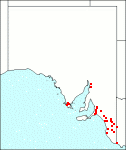Family: Orchidaceae
Caladenia patersonii
Citation:
R. Br., Prod. Fl. Nov. Holl. 324 (1810).
Synonymy: ?C. behrii Schldl., Linnaea 20:569 (1847); ?C. tentaculata Schldl., Linnaea 20:571 (1847); ?C. audasii R. Rogers, Trans. R. Soc. S. Aust. 51:295 (1927).
Common name: White spider-orchid, common spider-orchid.
Description:
Hairy, 20-50 cm high; leaf hairy, oblong to linear-lanceolate, sometimes quite short 2-15 cm long.
Flowers large, 10-15 cm diam., usually solitary, occasionally 2 or 3, generally white or creamy sometimes yellow, greenish, pink or wholly crimson, pale forms often with a red labellum apex or veining; perianth-segments all spreading or drooping except the dorsal sepal, with glandular-hairy tips but not clavate; dorsal sepal erect, drooping in some larger forms or incurred over the column, narrow-triangular to narrow-lanceolate the portion behind the column dilated, thereafter produced into a long tentacular point, usually 4.5-6 cm long; lateral sepals similar but spreading and drooping, rather longer, with a wider and longer dilated portion; petals shorter than the dorsal sepal, 4-5.5 cm long gradually tapering to glandular-pubescent filiform points; labellum 1.5-2 cm long, ovate-lanceolate, on a short claw, undivided, uniformly coloured with a maroon tip, veins and calli, the basal half erect, with toothed or fringed margins, anterior portion recurved, sometimes purple or crimson, the margins bluntly toothed or serrate or crenulate with an acute tip; calli of lamina rarely extending beyond the bend, linear-club-shaped, in 4-6 rows, loose; column incurved, 8-15 mm long, winged narrowly in the lower part, widely above; 2 yellow sessile calli at the base; anther blunt or pointed.
Published illustration:
Fitzgerald (1877) Australian orchids vol. 1, pt 3; Cunningham et al. (1982) Plants of western New South Wales, p. 196.
|
|
Distribution:
|
Occurs in small to extensive populations in a wide range of soil types and habitats in areas receiving greater than 300 mm mean annual rainfall but becoming scarce in most districts.
All States except the N.T.
|
Conservation status:
native
Flowering time: Sept. — Nov.
|

SA Distribution Map based
on current data relating to
specimens held in the
State Herbarium of South Australia
|
Biology:
A highly polymorphic species with many colour variations and forms; several varieties have been recognised throughout Australia, which differ mainly in size and colour of the perianth-segments: var. concolor (Fitzg.) J.H. Willis & Court with glossy red or maroon flowers; var. pallida (Lindley) Reichb. f. having greenish-yellow flowers, often with clavate sepals and petals; var. longicauda (Lindley) R. Rogers with large white flowers having very long sepals (up to 10 cm in some S.Aust. specimens) and having more deeply fringed labellum margins; and var. suaveolens Nicholls with sweet-scented yellow-green flowers. Putative hybrids have been reported with C. dilatata (SL, SE), C. gladiolata (FR), C. aft. huegelii (SL), C. latifolia (YP) and C toxochila (YP).
Author:
Not yet available
|

